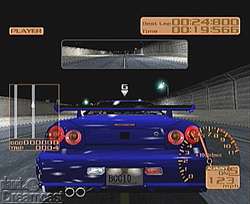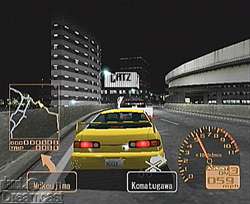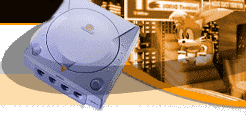| |
Tokyo Xtreme Racer 2
Racing the night away - Review By digitaltaco
 These long nights spent driving on the Tokyo highway can be taxing on the soul. With nobody around for miles except the occasional big rig or police cruiser, I welcome the sight of another night owl like myself cruising the cold, concrete rivers that float through the sky. A potential challenger in my sights, the only thing left to do is buckle my seatbelt, turn the music way up, and let him know that I'm ready... ready to race! These long nights spent driving on the Tokyo highway can be taxing on the soul. With nobody around for miles except the occasional big rig or police cruiser, I welcome the sight of another night owl like myself cruising the cold, concrete rivers that float through the sky. A potential challenger in my sights, the only thing left to do is buckle my seatbelt, turn the music way up, and let him know that I'm ready... ready to race!
When the Dreamcast was released last September 9th, there were nineteen games sitting along the shelves next to Sega's shiny new console. Because of the presence of some instant-classics such as the blockbuster 3D fighter Soul Calibur, and the 3D platforming megahit Sonic Adventure, some of these launch titles were quickly overlooked. Most prominent in this bunch were a slew of racing games, including Genki and Crave's Tokyo Xtreme Racer. Though some found its single, long track to be boring and the control weak, the novelty of racing against rivals in a fighting-game-like fashion was enough to draw good reviews from around the gaming community. Flash forward to the present. Taking into account criticisms of the original title, Genki and Crave went to work creating what would is likely one of the most highly anticipated racers in the Dreamcast's 2000 line-up: Tokyo Xtreme Racer 2.
The Good

Nice, eh? You can even read the customizable license plates. |
While it outwardly resembles most other racing games on the Dreamcast, Tokyo Xtreme Racer 2 sets itself apart from the pack with its distinctly original gameplay systems. First, the gamer must choose one of the four featured racing modes: Quest, Quick Race, Time Attack, and Free Run. The uniqueness of this title, most of the fun, and a good portion of its gameplay comes in the Quest mode. To begin with, you're given a fixed number of credits to buy an automobile with. From the start, this amount will only be enough to afford a cheap car and a few upgrades, and then it's off to the races. The game drops the player onto the Tokyo highway where he must then travel in search of a rival, indicated on the map by a colored arrow. Once a rival has been located, a quick tap of the headlight button transforms the game from a quiet romp around the streets into a fender-to-fender, one on one grudge match versus your chosen opponent. Gameplay then proceeds in fighting game fashion complete with energy bars that deplete whenever a racer is behind his opponent. The farther behind a racer falls, the faster his life bar drains. Also, collisions with walls or other vehicles will cause the energy bar to drain further. These races tend to be fast and intense as one driver overtakes the other over and over again until one submits to defeat. After a racer's energy is completely gone, the race is over and credits are awarded to the winner. The player is finally treated to a replay then popped once again back onto the highway looking for another rival to race. It's this simplistic act of challenging and defeating rivals that makes the game so unique and lends itself to long periods of play. The other play modes offer different ways to race around the highway. The Quick Race mode acts as a Survival Mode in a fighting game would, in that the player is placed in one rival race after another without regaining health in his energy bar. Time Attack involves racing one lap around the highway for the best time. And finally, Free Run is basically a practice mode where the rivals are removed and the player can hone his driving skills on the highway without worrying about the races themselves.
The original Tokyo Xtreme Racer was criticized for having somewhat "floaty" control that forced players to constantly drive into walls. However, because it didn't slow the car down too much, intentionally colliding with the barriers actually became a racing tactic. Seeing as this was rather non-realistic, Genki chose to make the cars more maneuverable in this sequel. Though some of the C-Class (cheaper) cars do suffer from bad control, it's simple because that (like in real life) these cars are not suited for high-speed racing. After making some cash and purchasing a new car or two, players will notice that the more expensive cars handle perfectly. When approaching a turn in an A-class vehicle, slamming the brakes, releasing the accelerator, and downshifting will cause the car to slide nicely around the corner. Overall, the control seems to be about as good as it gets in an arcade-like racing game.

The trackside detail varies between areas, going from sparse to relatively good. |
What about the track design? Good question, since this is an area of the original Tokyo Xtreme Racer that really needed some work. Though the game basically only has one track, it is much, much longer than the original's, covering about one hundred miles of pavement. There are dozens of branching paths to take, complete with signs that let the player know where he's headed. The ability to learn every inch of the track is the key to navigating through it successfully, and will provide the extra edge needed to win. The gameplay in the quest mode lends itself to a really long, branching track, and TXR2 has that covered.
Also worthy of praise is the AI, which is very realistic and gives some welcome personality to the different rivals the player will challenge. Computer-controlled racers will attempt to run the player into walls, and use the different branches of the freeway to lose you. Some rivals will even decline a challenge to race, then immediately drop behind and challenge you instead, seemingly as a taunt. Different rivals also offer varied difficulty levels based on their vehicles. Some will only come out when the others on their team have been defeated, and will then challenge you to a race to avenge the losses of their teammates.
Another area of the game that has been much improved from the first is the graphics. Tokyo Xtreme Racer suffered from low-polygon car models that looked very unrealistic, even if they did have excellent environment-mapping which made them shine like they had just been driven from the showroom floor. In Tokyo Xtreme Racer 2 the beautiful, "new-car" sheen is back, but this time it's accompanied by high-polygon models that closely resemble real-life cars. Though the game doesn't actually feature licensed vehicles, they have blatantly recreated some highly recognizable models from the real world. For example, the 2000 two-door Honda Accord may not be featured by name, but there is a car that looks almost exactly identical to it. The player can upgrade his car and the model accurately reflects the changes that are made, even during gameplay. Purchase a new muffler, and it will be visible when driving. Very nice.
Next: More Good, The Bad, and The Final Word

|

